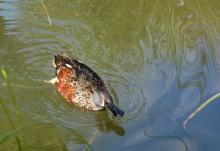Fish & Game mounts nationwide bird-counting mission
- 3/08/2015
Up to 50 Fish & Game officers and volunteers around New Zealand head out on a major game bird-counting mission today – focused on the shoveler duck, or ‘spoony.’
 The annual survey is carried out nationally every August by officers in all 12 Fish & Game regions, helped by volunteers including Ornithological Society members.
The annual survey is carried out nationally every August by officers in all 12 Fish & Game regions, helped by volunteers including Ornithological Society members.
Coordinator Senior Fish & Game Officer Matthew McDougall says the aim is to ensure that Australasian shoveler populations are properly monitored and managed.
We need to be sure the populations are healthy and not at any risk of being “over harvested” during the game bird season, he says.
“Most Fish & Game regions have a daily bag limit of two per hunter but most hunters don’t get anywhere near this.”
The shoveler counting methods are simple; officers armed with binoculars or spotting scopes head out by vehicle, on foot and even by boat to count the birds at around 290 sites around the country.
“The sites have been chosen as key shoveler habitat,” Mr McDougall says, “often shallow ponds in lowland areas, including effluent treatment ponds often full of insects the ducks feed on.”
“We pick observation points which provide good views of the bird’s habitat.
“We value the help that volunteers give us with this count, especially in parts of the country where our staff resources are limited.”
At some spots there are large concentrations of the birds, such as Lake Poukawa in the Hawkes Bay where up to 3000 shoveler have been counted.
Mr McDougall says the shoveler is quite a mobile species, “they tend to travel large distances and can move from region to region.”
The earlier surveys of the “indicator sites” suggest that the shoveler populations have remained fairly stable over time with total counts of the sites Fish & Game surveys running to well over 10,000 birds.
The shoveler count is but one part of the research work being done on game bird populations, with an extensive research programme on mallard ducks now well advanced.
The mallard project is a significant research effort by Fish & Game, focused on trying to determine what the species requires to sustain a good, stable and huntable population.
The research team is looking at mallards in both the North and South Islands, focussing on Waikato and Southland because of those regions’ reputation as prime mallard hunting areas.
The banding of mallard ducks in the North Island, which normally begins in early January, is another element of the population monitoring work which includes aerial observations.
FURTHER INFORMATION
Senior Fish & Game Officer Matthew Mc Dougall Tel 07-357 5501 Mob 021-278 940